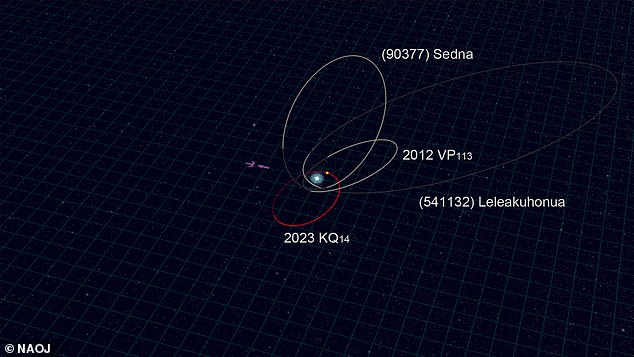[ad_1]
Astronomers have discovered a new world circling the outer edges of our solar system.
Researchers using the Subaru Telescope, located in Hawaii, spotted a small, distant object called 2023 KQ14 far beyond Pluto. They’ve given it the nickname Ammonite.
2023 KQ14 is a rare type of object called a ‘sednoid,’ a small, icy body in the outer solar system, similar to the icy rocks floating in the Kuiper Belt or dwarf planets like Pluto.
So far, there are only four known objects like it in our solar system. 2023 KQ14 is about 71 times farther from the sun than Earth is.
This object follows a unique, stretched-out orbit that has stayed stable for about 4.5 billion years.
Scientists found that 2023 KQ14’s orbit was similar to the other sednoids in the solar system for billions of years, but that has mysteriously changed over time, suggesting the outer solar system is a more complex space than we thought.
This discovery also makes the possible existence of ‘Planet Nine’ less likely, as 2023 KQ14’s orbit doesn’t quite fit with where scientists believe that world would be.
Dr Yukun Huang from the National Astronomical Observatory of Japan said: ‘It is possible that a planet once existed in the solar system but was later ejected, causing the unusual orbits we see today.’

Researchers using the Subaru Telescope, located in Hawaii, spotted a small, distant object far beyond Pluto and have named it 2023 KQ14
Planetary scientist Fumi Yoshida added that Ammonite was found in a region of space far beyond the influence of Neptune’s gravity
‘The presence of objects with elongated orbits and large perihelion distances in this area implies that something extraordinary occurred during the ancient era when 2023 KQ14 formed,’ Yoshida explained in a statement.
Scientists are calling Ammonite a cosmic ‘fossil’ from the beginnings of the solar system.
The discovery was part of the Formation of the Outer Solar System: An Icy Legacy (FOSSIL) survey project.
The project’s name itself reflected the goal of finding objects like Ammonite that act as ‘icy fossils,’ preserving information about the outer solar system’s formation and evolution.
‘I would be happy if the FOSSIL team could make many more discoveries like this one and help draw a complete picture of the history of the solar system,’ Yoshida said.
Until now, astronomers had been focused on proving the existence of the fabled Planet Nine (or Planet X as NASA calls it), a mysterious ninth planet believed to be hiding far beyond Pluto at the edge of the solar system.
A recent study had whittled a list of 13 candidates down to just one potential object slowly moving around our sun approximately 46.5 billion to 65.1 billion miles away.

2023 KQ14 is a rare type of object called a ‘sednoid,’ a small, icy body in the outer solar system. So far, there are only four known objects like it in our solar system

Beyond Neptune is a region of the solar system called the Kuiper Belt, where Pluto and other ice fragments sit. All 4 sednoids sit in this region as well
To put that in perspective, that hypothetical planet would be almost 20 times farther away from the sun than Pluto is.
However, the Japanese team’s discovery of Ammonite (2023 KQ14) challenges the Planet Nine theory, as its unique orbit suggests that Planet Nine, if it exists, would need to be even farther from the sun than previously thought.
This has led the researchers who discovered Ammonite to hypothesize that a mystery planet (possibly Planet Nine) was somehow thrown out of its orbit around the sun long ago.
Scientists had been using the Planet Nine theory to explain some of the unsolved mysteries still surrounding our tiny corner of the Milky Way galaxy.
In a breakdown of Planet Nine, NASA said: ‘It could also make our solar system seem a little more ‘normal.’
‘Surveys of planets around other stars in our galaxy have found the most common types to be ‘super Earths’ and their cousins — bigger than Earth, but smaller than Neptune,’ NASA researchers continued.
‘Yet none of this kind exist in our solar system. Planet Nine would help fill that gap.’
If astronomers had found a giant planet at the rim of the solar system, it could explain why objects in the Kuiper Belt are tilted by about 20 degrees with respect to the plane the planets sit on as they orbit the sun.
Planet Nine’s gravity would be pulling on these objects over long periods of time, tilting their orbits so the entire ice belt would be out of line with the planets.
The existence of Planet Nine and its strong gravity would also explain why all these comets and tiny dwarf planets like Pluto all cluster together and move in the same direction without floating away.
[ad_2]
This article was originally published by a www.dailymail.co.uk . Read the Original article here. .

